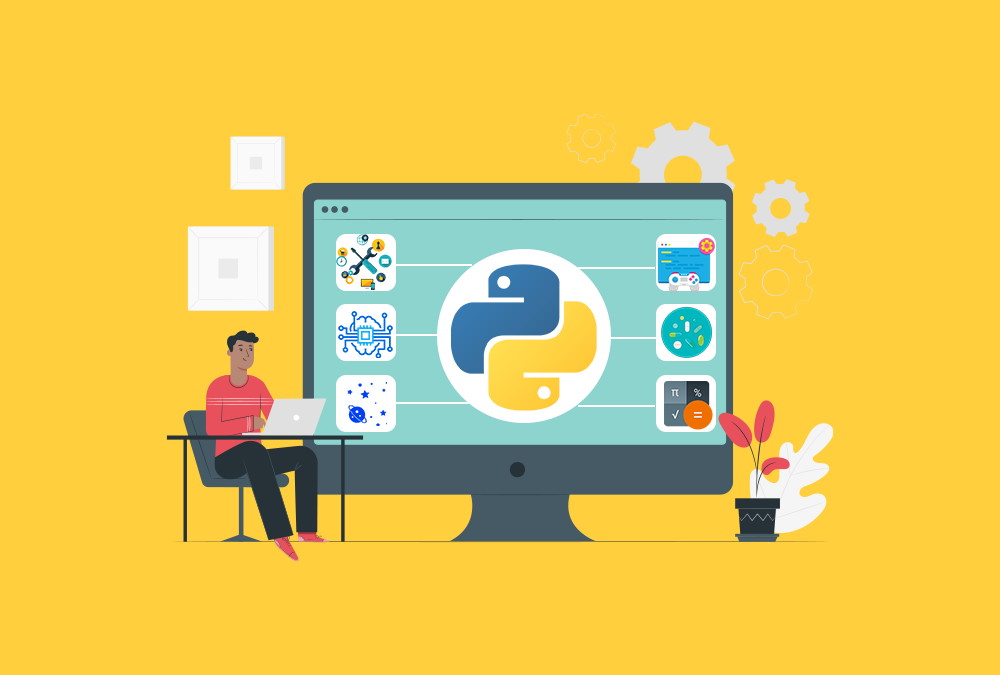Python is currently one of the most popular programming languages, and Python developers are in high demand. It is a versatile programming language that is used by software professionals and IT companies all around the world. Data scientists use it for data cleansing, analysis, and knowledge production.
Python is a popular high-level, general-purpose, object-oriented programming language. Because of its versatility, it is one of the most used coding languages. The language was designed with code readability in mind, and it supports many programming paradigms.
Python includes high-level data structures, dynamic binding, dynamic typing, and other characteristics that make it suited for developing complicated applications. Python versions are copyrighted under a GPL-compatible license approved by the Open Source Initiative. Python is widely regarded as appropriate for general-purpose activities such as mining and big data processing.
Applications of Python Programming
Python supports cross-platform operating systems (Mac, Linux, and Windows), making it easier to develop applications. Here are a few examples of where Python shines in application development.
- Back-end or server-side web development
- Development of mobile applications
- Development of desktop applications/software
- Processing of Big Data
- Calculations in mathematics
- Writing system scripts
Top Advanced Python Concepts You Must Understand
Python is a high-level, object-oriented programming language that has lately gained popularity among students and professionals due to its adaptability, dynamic nature, resilience, and ease of learning. Not only that, but it is now the second most popular and preferred programming language after JavaScript, and it can be utilized in practically all technological domains; machine learning, data science, web development, analytics, automation, testing, and artificial intelligence are just a few examples.
When compared to other high-level, object-oriented programming languages like Java or C++, learning Python is straightforward. Still, it includes a few sophisticated features that help when producing resilient, crisp, highly optimized, efficient and normalized code. Using these concepts in your code will eliminate problems and boost productivity, transforming you into a seasoned Python programmer. So, let us go through these principles individually and ensure we understand them well!
The Map Function
Python includes a function named map that allows us to process all components in an iterable without explicitly utilizing a looping construct. When called, it returns a map object, which is an iterator. This map object represents the outcome of applying the supplied function to each item in the iterable.
Itertools
Python offers an excellent standard library called itertools that includes several methods that aid in creating clean, quick, and memory-efficient code through lazy evaluation. It is a Python module that implements numerous iterator building blocks that, when combined, form ‘iterator algebra,’ allowing for the efficient development of Python tools. Itertools functions operate on iterators, returning more complicated iterators in return. Itertools functions include count, cycle, repeat, accumulate, product, permutations, combinations, and so on, each of which takes its own set of inputs and operates on them. The outcome is far faster than the results obtained using conventional code.
The Lambda Function
Lambda functions in Python are short anonymous functions that don’t have a name and are contained in a single line of code. In Python, functions are defined with the keyword ‘def,’ while lambda functions are defined with the keyword ‘lambda.’ They can take any number of arguments but only one expression at a time. It makes code for simple logical processes more short and easy to read, and it is best used when the function is only used once.
Expressions using Regular Expressions
Regular expressions, often known as RegEx in Python, contain specified characters as patterns to be matched. It determines whether a string or a set of strings contains a particular pattern. It is mighty, elegant, concise, and quick. To utilize regular expressions in Python, import the re module, which offers pattern-matching functions such as find, search, split, and so on.
These are the top advanced Python principles that every Python developer should understand. These will not only make you a better programmer and developer, but they will also increase code readability and speed.
Python has grown in popularity throughout time, from an obscure programming language to one of the world’s most popular and frequently used languages.
You’ll learn advanced topics in the Advanced Python course, which will set you apart from most Python developers.
